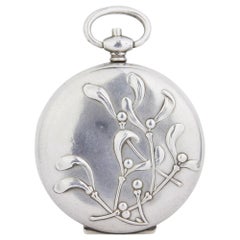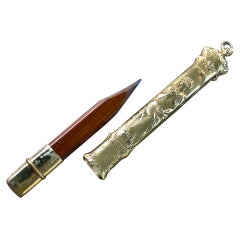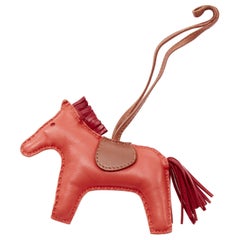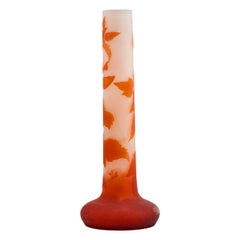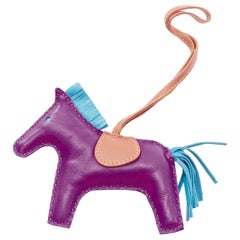French More Objets d'Art and Vertu
to
11
42
19
13
12
9
11
7
6
5
5
2
23
42
4
7
2
3
5
3
5
2
3
1
2
2
59
12
6
5
4
4
3
to
13
2
2
1
1
12
11
3
3
2
2
2
1
1
64
7
33
30
Place of Origin: French
Large French Silver Mistletoe Locket
Located in Brisbane City, QLD
A very fine French silver locket featuring mistletoe to both sides. It has a gold wash interior to prevent tarnish and closes firmly. It appears to be struck with the French guarante...
Category
Early 1900s Art Nouveau Antique French More Objets d'Art and Vertu
Materials
Silver
Antique Wooden Pencil Holder Gold Art Nouveau Female Body Floral Ornament
Located in Berlin, DE
An Art Nouveau period Antique necklace - wooden pencil with gold holder
France, circa 1900s
total weight - 11 grams
necklace measurements - 0.39 x 3.62 ...
Category
Early 1900s Art Nouveau Antique French More Objets d'Art and Vertu
Materials
Gold, Yellow Gold
$2,341 Sale Price
60% Off
HERMES Milo Rodeo MM red leather brown trim fringed tail horse charm
By Hermès
Located in Hong Kong, NT
HERMES Milo Rodeo MM red leather brown trim fringed tail horse charm
Reference: AAWC/A01026
Brand: Hermes
Model: Milo Rodeo MM
Material: Leather
Color: Red, Brown
Pattern: Solid
Clos...
Category
21st Century and Contemporary French More Objets d'Art and Vertu
$532 Sale Price
25% Off
French Tissot 18K Yellow Gold Damascene Steel Belt Buckle
By Tissot
Located in London, GB
A blackened steel and 18 karat (18K) yellow gold Damascene belt buckle designed as a rectangle with inlaid gold designs of angels and geometric lines in...
Category
1880s Art Nouveau Antique French More Objets d'Art and Vertu
Materials
Gold, 18k Gold, Yellow Gold, Steel
Emile Galle Art Deco Vase
Located in Tel Aviv, IL
Emile Galle Art Deco Vase
Beautiful Art Deco piece that was made in France in the 1930s
An overlaid and etched glass vase, cameo signature G...
Category
1930s Art Deco Vintage French More Objets d'Art and Vertu
HERMES Rodeo PM purple leather brown trim fringed tail horse charm
By Hermès
Located in Hong Kong, NT
HERMES Rodeo PM purple leather brown trim fringed tail horse charm
Reference: AAWC/A01025
Brand: Hermes
Model: Rodeo PM
Material: Leather
Color: Purple, Brown
Pattern: Solid
Closure:...
Category
21st Century and Contemporary French More Objets d'Art and Vertu
$427 Sale Price
25% Off
Daum Nancy Art Deco Vase
Located in Tel Aviv, IL
Daum Nancy Art Deco Vase
Cameo glass vase, monumental landscape, signed Daum Nancy
From the 1930s.
Category
1930s Art Deco Vintage French More Objets d'Art and Vertu
$8,500
Vintage Ruby and Gold Cufflinks
Located in Geneva, CH
Ruby, Mother of Pearl and Gold Cufflinks.
Diameter: 1.80 cm.
Chain length: 2.00 cm.
Category
Mid-20th Century Art Deco French More Objets d'Art and Vertu
Materials
Ruby, Gold
Cartier Paris Belle Epoque Garland Style Enamel Diamond Gold Belt Buckle
By Cartier
Located in New York, NY
Cartier enamel and diamond belt buckle. French
The domed rectangular buckle decorated with green guilloché enamel and white enamel borders, set with rose-cut diamond flower-head, c...
Category
Early 20th Century Belle Époque French More Objets d'Art and Vertu
Materials
Diamond, 18k Gold, Gold, Enamel
Crystal Flask with Gold and Pearls, Late 19th Century Work
Located in Paris, FR
eardrop-shaped crystal flask in pierced gold mount, intricately sculpted with hearts, palmettes, and scrollwork. The mounting is set on the base and the ...
Category
1890s Antique French More Objets d'Art and Vertu
Materials
Crystal, Pearl, Gold
Crystal Flask with Gold, Late 19th Century
Located in Paris, FR
Peardrop-shaped crystal flask in gold mount. The body is finely engraved with an interlaced monogram. The mounting is decorated with an intricate engrave...
Category
1870s Napoleon III Antique French More Objets d'Art and Vertu
Materials
Crystal, Gold
Still Thinking About These?
All Recently ViewedMore Ways To Browse
Russian Porcelain Eggs
Tequila Knife
Vintage Dubarry Jewelry
Disney Brooch
Edwardian Diamond Heart Brooch
Enamel And Gold Rocking Horse Brooch
Enamel Brooch Peacock
Fairy Brooch
Faux Chanel Brooch
Fedoskino Brooch
Garnet 5 Ct
Garnet Scarab
Georg Jensen Amethyst
Georg Jensen Bird
Georg Jensen Brooches Antique
Gianni Versace Brooch
Giorgio Visconti
Gold Cameo Left
